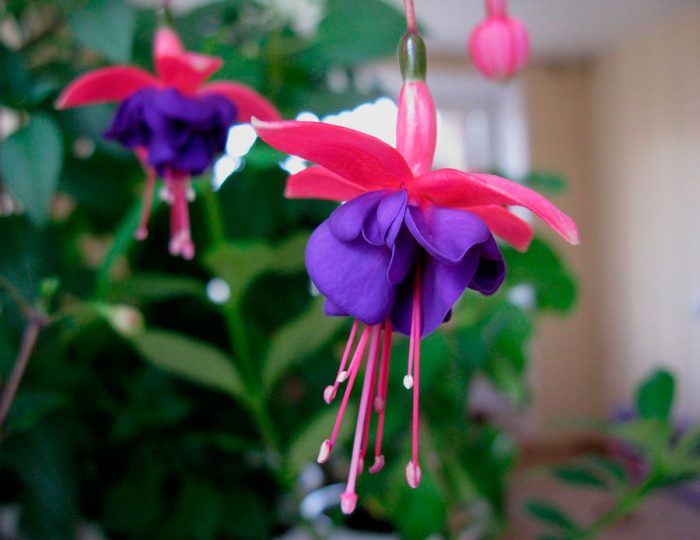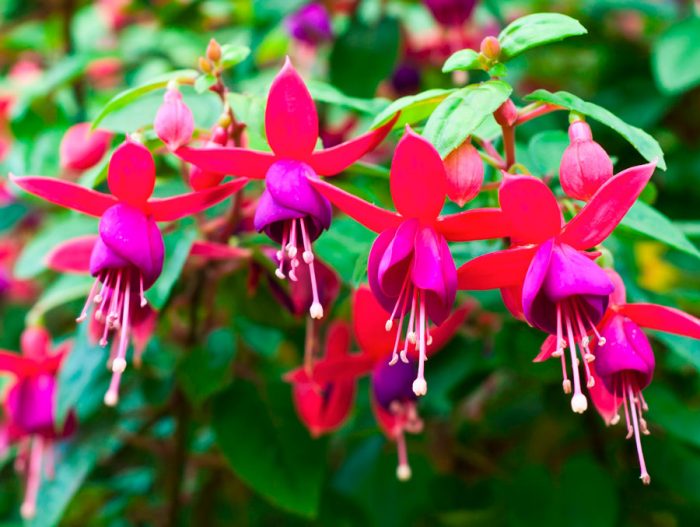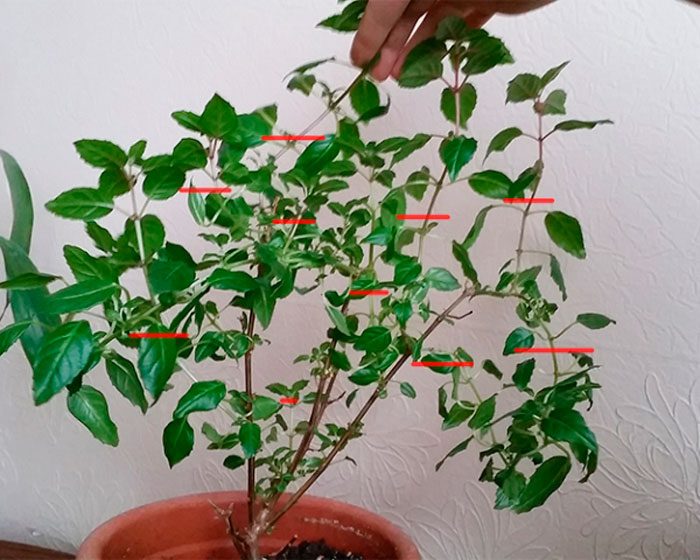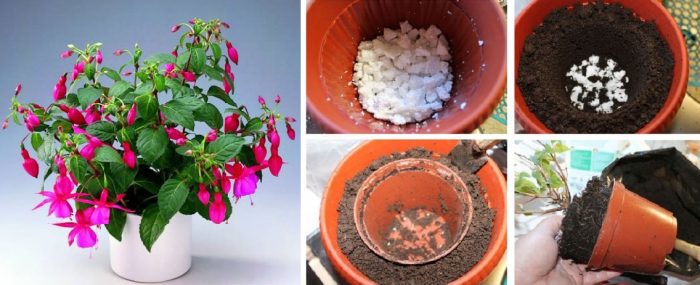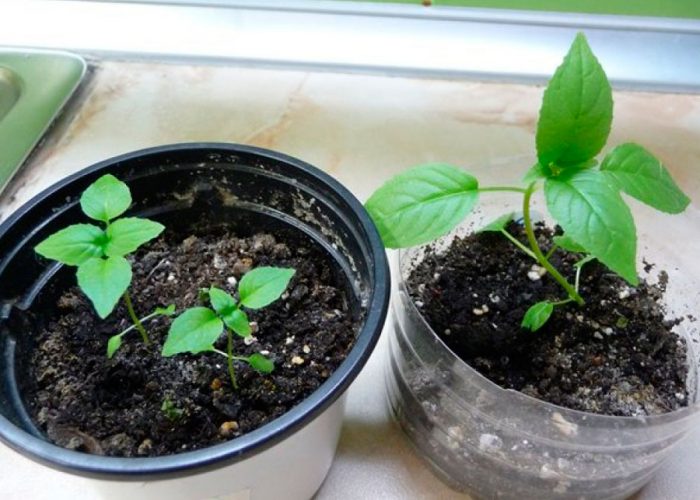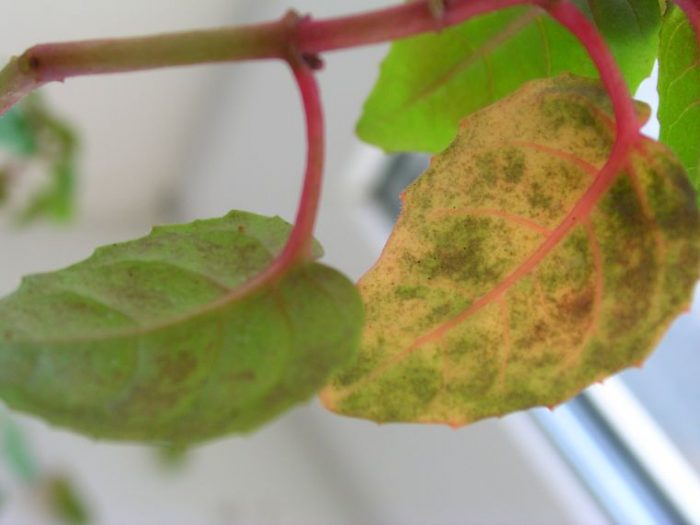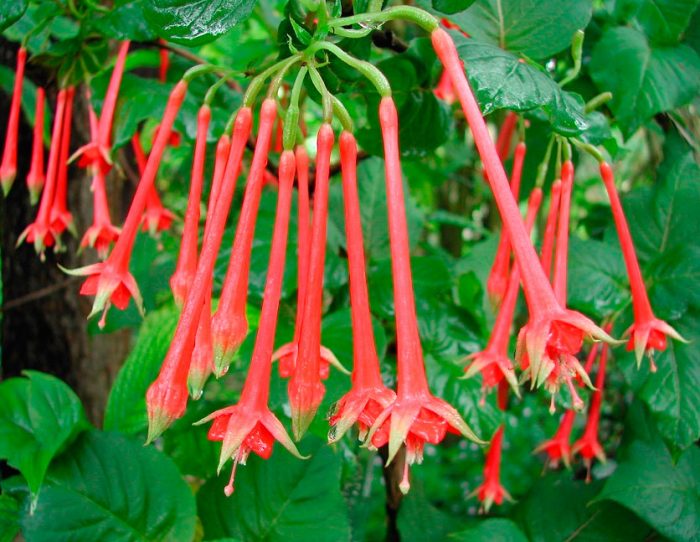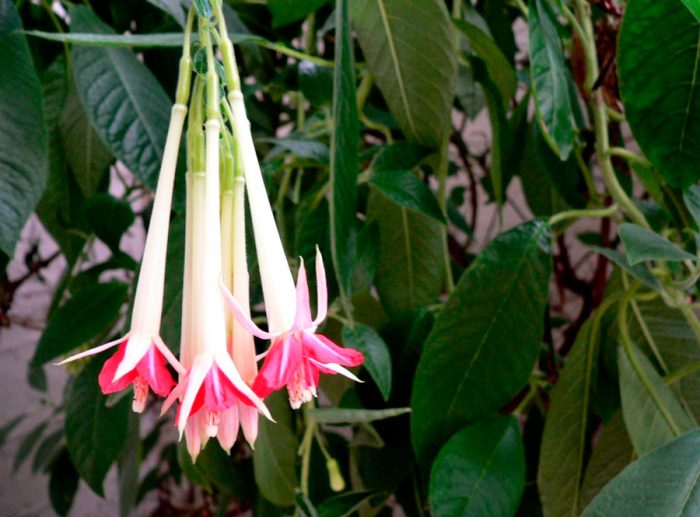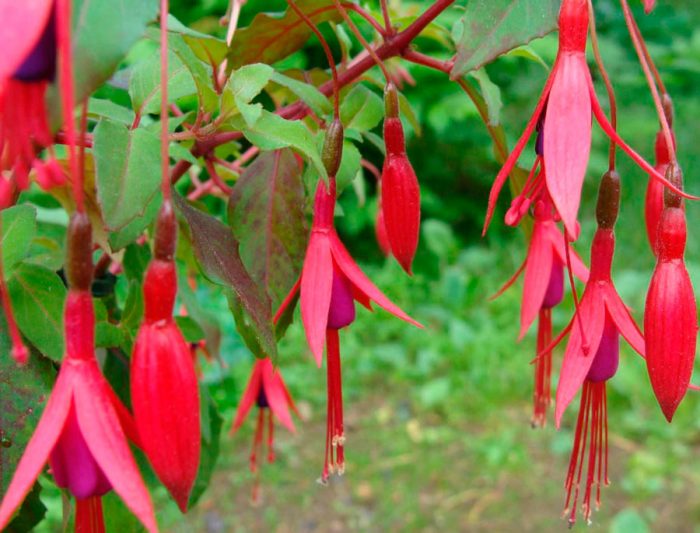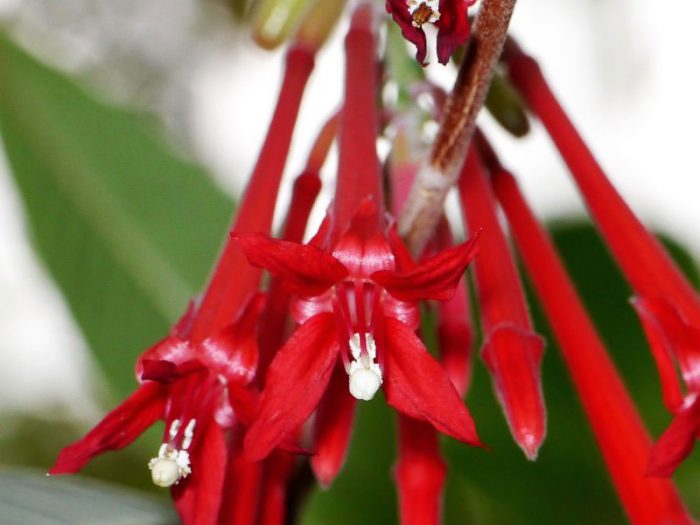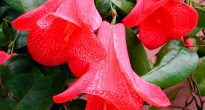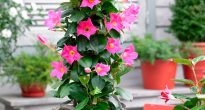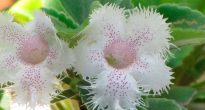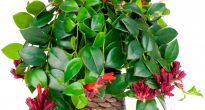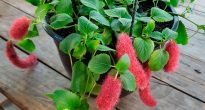The fuchsia plant (Fuchsia) is a member of the Fireweed family. This genus unites about 100 species. This plant was named after Fuchs, who was a German botanist. In nature, fuchsia can be found in Central and South America. Such a plant is represented by small shrubs and trees. In some species, foliage is opposite, while in others it grows in whorls. At the end of the growing season, some of the species fly around all the foliage. The shape of the leaf plates is elongated-oval, lanceolate or ovoid, and their edge can be with small notches or solid. The elongated tubular calyxes of flowers with long stamens can be red or white. Both an experienced florist and a beginner can grow fuchsia, because caring for it will not be difficult. It can be grown as a standard tree, as well as an ampelous plant. If you decide to start growing it, then you should immediately take into account that in winter it must be in a cool place, and you also need to remember that all the foliage flies from a faded bush.
Content
Brief description of cultivation
- Bloom... It starts in the spring and ends in late autumn.
- Temperature regime... During the growing season from 18 to 24 degrees, and in winter - from 5 to 10 degrees.
- Watering... In March-September, the bush is watered immediately after the top layer of the substrate dries out, and since the last days of November this is rarely done, but care must be taken that the clod of earth in the pot does not dry out completely.
- Air humidity... In May-August, the bush is moistened from a spray bottle with lukewarm water every day in the evening and morning, and in the autumn months this is done once every 2-3 days. In winter, you do not need to spray the plant.
- Fertilizer... In April – September, fuchsia is fed 2 times a month, using a complex mineral fertilizer for flowering plants.
- Dormant period... From the last days of October to the end of January.
- Pruning... At the beginning of intensive growth. In ampel varieties, the stems do not need pruning.
- Transfer... It is carried out once a year in the first days of March after the bush is pruned.
- Soil mixture... Peat, leafy earth and sand (2: 3: 1).
- Reproduction... By cuttings and seed method.
- Harmful insects... Spider mites and whiteflies.
- Diseases... Rot and mottling. The plant may become less effective due to violations of the rules of care or improper maintenance.
Fuchsia home care
Illumination
Western or eastern windows are best suited for growing fuchsia, because it needs a lot of bright light, but it must be diffused. In the morning and evening, she calmly withstands the direct rays of the sun. When growing a flower on a south-facing windowsill, so that burns do not appear on it, it must be protected from direct rays of the sun with translucent paper or cloth. If, however, choose a northern window sill for growing fuchsia, then it will lack light, which will lead to stretching of the branches, and will also have an extremely negative effect on flowering (it will not be at all or it will be scarce). During flowering, the bush should not be disturbed (rearranged or turned), otherwise all the buds, flowers and foliage can fly around it. In the warm season, the bush can be rearranged to fresh air, but it is necessary to gradually accustom it to new conditions.
Temperature regime
During the growing season, the air temperature should be 18-24 degrees. For wintering, you need to choose a well-lit and cool place (5-10 degrees). It should be remembered that the plant must necessarily winter in the cool. In a warmer place, all the foliage flies from the bush, and the stems become elongated. Fuchsia needs regular ventilation, but it must be protected from drafts, as they can cause her death. In the warm season, the bush can be transferred to the balcony, while for it you should choose a place that will be protected from direct sunlight, drafts and precipitation.
Watering
For irrigation, use well-settled soft water at room temperature. In March-September, watering is carried out immediately after the top layer of the substrate dries out, the fact is that at this time the soil mixture in the pot should be a little damp all the time. From the first days of October, it is necessary to begin to gradually reduce watering, while by the last days of November watering should become very rare and scarce, thanks to which the flowering will be more magnificent in the next season. If in winter the flower is in a cool place (less than 10 degrees), then watering is carried out extremely rarely, and if at this time it is warmer than 10 degrees in the room, then the frequency of watering should be slightly increased.
Spraying
For spraying, soft water is used, while it must be well settled (at least 24 hours). In May – August, spraying should be carried out twice a day (early morning (before 9 am) and late in the evening (after 6 pm)). In winter, it is not necessary to moisten the bush from the sprayer.
Fertilizer
Top dressing of such a flower is carried out in April – September 1 time in 15–20 days, for this they use a complex mineral fertilizer for indoor plants. Fuchsia is not fed in winter.
Bloom
If you take proper care of fuchsia grown at home, it will bloom for a very long time, or rather, from May to November, and it will also be able to give juicy berry-like fruits. In order for the bush to form young buds more actively, it is necessary to pick off wilted flowers in a timely manner. To extend flowering until December, in July, the bush must be rearranged on the balcony, and during the summer period it must be cut 3 times.
Fuchsia pruning
If such a plant is at room temperature in winter, then because of this, the foliage may fall off, and the stems will become elongated. Since the formation of flower buds is observed mostly on young stems, in order for the flowering to be more lush, old bare shoots must be removed (if desired, they can be used as cuttings). Pruning and pinching of the bush is carried out during the entire growing season. After 3 pairs of true leaf plates grow on young shoots, they need to be pinched.
To form a tree, it is necessary to tie 1 of the vertically growing stems to a support, which is also placed vertically.All lateral stems should be cut regularly until the trunk reaches the required height. Then you need to cut off the top of the tree and allow several lateral stems (from 3 to 5) to grow, of which the crown will consist. A spectacular dense crown of such a tree will form after 3 years.
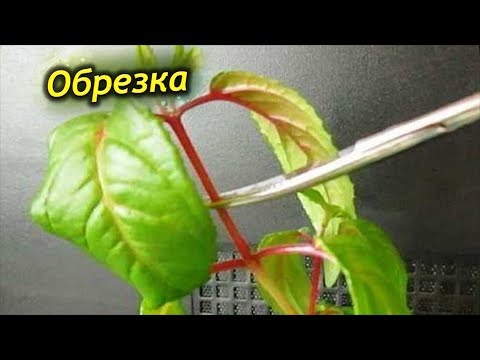

Watch this video on YouTube
Fuchsia transplant
This flower is transplanted once a year in the first spring weeks. Before replanting the bush, its old stems must be shortened by at least 1/3, and the root system is also slightly trimmed. If fuchsia is cultivated as an ampelous plant, then its stems do not need to be cut, otherwise it will become less effective. A slightly acidic substrate is used for transplantation, which includes peat, deciduous soil and sand (2: 3: 1). You can also use another substrate, consisting of sand, greenhouse and clay-sod land (1: 2: 3), and even a small amount of peat chips.
First, a drainage layer must be made at the bottom of the pot, which should occupy 1/5 of the container. The transplanted bush needs to be very well moistened from a sprayer, and also watered abundantly, then it is transferred to a place where the light is bright, but diffused. In the middle of the summer period, if desired, you can carry out a second transplant, while using a fresh soil mixture.


Watch this video on YouTube
Reproduction methods
Seed (generative) reproduction
To collect seeds from indoor fuchsia, its flowers will need artificial pollination. If there is a desire to get a new hybrid, then during pollination it is necessary to use different types of fuchsia, which differ from each other in color and shape of flowers.
Cuttings
When preparing cuttings, it should be noted that their length should be from 50 to 70 mm. In order for the cuttings to take root, they can be planted in the sand or placed in a container of water. The cuttings will develop roots in about 20-30 days. For planting rooted cuttings, separate pots are used, reaching 90 mm in diameter, which are filled with a soil mixture consisting of sand, humus, turf and leafy soil (1: 1: 1: 1). In order for the bushes to grow spectacular and thick, several cuttings must be planted in 1 pot at once. Such bushes should have flowers in the same year. For the propagation of slow-growing fuchsia species, the grafting method is used, while this procedure is carried out in the last summer weeks.
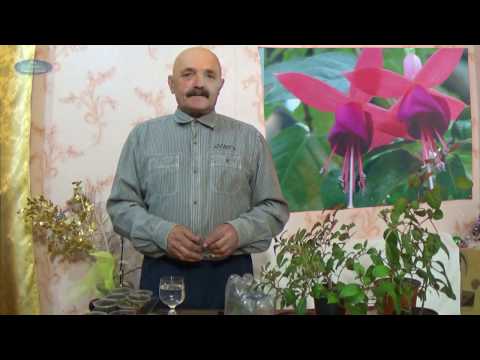

Watch this video on YouTube
Possible problems
Fuchsia reacts extremely negatively to stagnant air, therefore, during the growing season, the room where the flower is located must be systematically ventilated, or the pot with the plant can be transferred to the balcony.
Fuchsia fades quickly
There are several reasons that the bush fades relatively quickly:
- if in winter the bush was watered abundantly and it was warm;
- if in the spring-summer period the lighting was excessively poor;
- if the bush was fed and watered in the summer less often than necessary.
Fuchsia leaves are falling
If the foliage flies around in winter, then the bush must be removed from bright light, while the buds that are forming must be pinched. Still flying around the foliage can be associated with excessively poor watering, too low air humidity and very high temperature. Fuchsia can shed its buds under excessively poor lighting, untimely watering and very high air temperatures.
Fuchsia leaves
The bush is affected by spotting if it is watered excessively in winter.
Fuchsia dropped buds
During the period of bud formation, as well as flowering, it is forbidden to disturb the bush, since if you rearrange it or turn it, then all the buds will fly around it.If the flower is exposed to a draft, then its buds will all fall off as well.
Harmful insects
Most often, a spider mite, as well as whiteflies, settle on such a plant.
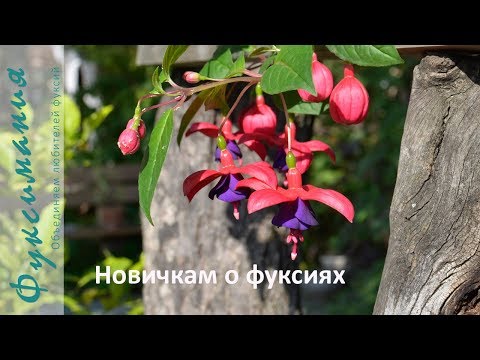

Watch this video on YouTube
Fuchsia types with photos and names
Fuchsia brilliant (Fuchsia fulgens)
This view comes from the mountains of Mexico. The height of this evergreen shrub is about 100–200 cm, its branched stems are bare. Large leaf plates have a heart-shaped or elongated-ovoid shape, they are naked, serrate along the edge. They are about 12 centimeters wide and up to 20 centimeters long. At the tops of the stems, hanging racemose inflorescences grow, which consist of pale red flowers with petals about 10 centimeters long, as well as a corolla tube tapering to the base up to 10 centimeters long. The fruit is a berry that you can eat. This species blooms throughout the summer.
Fuchsia boliviana (Fuchsia boliviana)
This species is found naturally in the mountainous regions of Ecuador, Argentina and Bolivia. The height of this evergreen shrub may slightly exceed 100 cm. The leaf plates pointed at the top have an elliptical or ovoid shape, they are finely serrated along the edge, their width is 6 centimeters, and their length is up to 15 centimeters. Flowering is observed in the first half of the spring. Apical racemose inflorescences consist of one centimeter flowers of dark red color.
Fuchsia magellanic (Fuchsia magellanica)
Either multi-colored fuchsia (Fuchsia discolor), or conical fuchsia (Fuchsia conica).
The height of this shrub is 200-500 cm. On the surface of the purple stems there is a slight pubescence. Lanceolate-ovate leaf plates can be alternately located or grow in whorls, collected in 3 pieces, their edge is serrated. Their length is about 50 mm, and purple streaks are clearly visible on the surface. Axillary flowers are collected in 4 pieces or are single. The color of the corolla tube is pale red, and the color of the petals is purple-blue. Flowering begins in the last weeks of spring and ends at the end of summer.
Fuchsia corymbose (Fuchsia corymbiflora)
In nature, this kind can be found on the slopes of the mountains of Peru and Ecuador. The height of the shrub with straight shoots is about 5 meters. On the surface of the oval whole-edged leaf plates there is a slight pubescence, their width is about 7 centimeters, and their length is up to 17 centimeters, the median vein is red. The petals are purple and the calyx tubes are red. This species blooms in July – August.
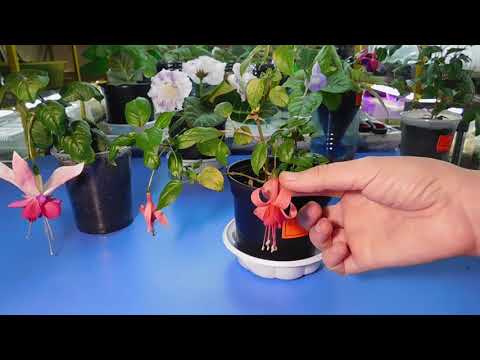

Watch this video on YouTube



